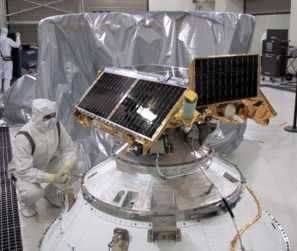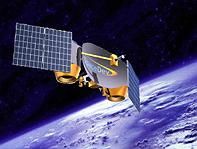
Home - Search - Browse - Alphabetic Index: 0- 1- 2- 3- 4- 5- 6- 7- 8- 9
A- B- C- D- E- F- G- H- I- J- K- L- M- N- O- P- Q- R- S- T- U- V- W- X- Y- Z
CHIPSat
 ChipSat Credit: SpaceDev |
Status: Operational 2003. First Launch: 2003-01-13. Last Launch: 2003-01-13. Number: 1 . Gross mass: 60 kg (132 lb).
Chipsat was a low-cost 40-kg, 60-watt, 3-axis stabilized microsatellite designed and built by SpaceDev for the University of California, Berkeley under a NASA-funded $6.8 million commercial fixed-price contract. SpaceDev had overall responsibility for the mission design, and the design, assembly, integration and testing of the CHIPSat microsatellite as well as designing the entire ground segment and establishing a Mission Control Center at SpaceDev headquarters in Poway, CA to test and operate the satellite.
In 1999, SpaceDev was selected as the mission designer; spacecraft bus provider, integrator, and mission operator of the University of California, Berkeley (UCB) Space Sciences Laboratory's (SSL) Cosmic Hot Interstellar Plasma Spectrometer (CHIPS) mission. CHIPS was NASA's first University Explorer (UNEX) mission. SpaceDev managed to control critical size, mass and power limitations, and delivered a highly innovative 40-kg, 60-watt, 3-axis stabilized satellite bus ready to integrate with the CHIPS science instrument, on-schedule, for about $6.8M.
The Cosmic Hot Interstellar Plasma Spectrometer (CHIPS) instrument would carry out all-sky spectroscopy of the diffuse background at wavelengths from 90 to 260 Angstroms with a peak resolution of /150 (about 0.5 eV). CHIPS data would help scientists determine the electron temperature, ionization conditions, and cooling mechanisms of the million-degree plasma believed to fill the local interstellar bubble. The majority of the luminosity from diffuse million-degree plasma was expected to emerge in the poorly-explored CHIPS band, making CHIPS data of relevance in a wide variety of Galactic and extragalactic astrophysical environments.
One of the most significant breakthroughs in the CHIPSat design was miniaturized avionics developed by SpaceDev and accomplished by the use of commercial parts, surface-mount technology, and state-of-the-art implementation of fully programmable gate arrays (FPGA). This was most evident in the power system that included fixed solar arrays on all sides to insure that CHIPSat was power positive in all attitudes. The entire power system, including the implementation of aviation NiCd cells for space use, accounted for a significant portion of the project cost savings.
Another major breakthrough was the command and data handling system that included a high-performance 300 MIPS flight computer using less than 3W average, a global watchdog timer, and a "firecode" system-reset switch outside the computer. The code development was minimal due to the implementation of a table-driven cmd/tlm interface and C/C++ software modules utilizing end-to-end TCP/IP-based connectivity among each spacecraft subsystem (including CHIPS), down to the ground station router, and to SpaceDev's Mission Control Center that utilizes SpaceDev-developed Windows NT-based mission control software - all running across a secure Internet link.
The Cosmic Hot Interstellar Plasma Spectrometer Satellite (CHIPSat) was the first U.S. mission to use end-to-end satellite operations with TCP/IP and FTP. This concept had been analyzed and demonstrated by the NASA OMNI team via UoSAT-12; however, CHIPSat was the first to implement the concept as the primary means of satellite communication. CHIPSat was launched at 4:45 p.m. on January 12, 2003 from Vandenberg Air Force Base.
CHIPSat BD II Spacecraft Bus Features
- 2-year development time - $10-15M total mission cost including launch
- Delta II compatible (SPE2 DPAF accommodation)
- Final orbit 550-700 Km, stable for >1 Year
- Host 35 Kg of CHIPS instrument and electronics mass
- RS-422 communication to/from CHIPS instrument
- Up to 30 Watts of 13 +/-2 volt power
- Attitude knowledge and accuracy within +/-2 degrees
- At least 50% duty factor active instrument pointing and operation
- Allowed observation of entire celestial sphere in 6 months while keeping instrument FOV from Sun, Moon, Earth, RAM and SAA.
- Spacecraft provided up to 16 commands/day (real time or time-tagged)
- CHIPS instrument and electronics maintained within operating temperature range of -10 deg c to +35 deg C
- Time tagging of each science data packet recovered to an accuracy of 5 seconds (absolute).
- Provided CHIPS integration, test, LV integration, launch operations
- 3-axis stabilized using 4 momentum wheels, 3 torque coils, 2-axis sun sensor, magnetometer, 4 rate sensors (located inside wheels)
- Nominally Sun pointing (within ~45 deg for nominal power)
- Complete freedom to yaw about solar array normal vector, allowing CHIPSat to avoid Earth and Moon
- SpaceDev Miniature Flight Computer (MFCT) PowerPC 750 single board computer running VxWorks® real time kernel
- SpaceDev general purpose Micro Space Vehicle Operating System (MS-VOST)
- SpaceDev general purpose mission control and operations service
NASA NSSDC Master Catalog Description
CHIPS (Cosmic Hot Interstellar Plasma Spectrometer) is an American (NASA) astrophysics spacecraft that was launched by a Delta 2 rocket from Vandenberg AFB at 00:45 UT on 13 January 2003. The 60 kg, triaxially-stabilized spacecraft has a spectrograph covering the 9-26 nm wavelength band at a resolution of 0.1 nm, scanning the entire sky in chunks of 5 degree x 27 degree segments during each orbit. The targets are the hot and diffuse nebulae at about a million degrees temperature. The band covers several strong emission lines.
More at: CHIPSat.
Family: Astronomy, Ultraviolet astronomy satellite. Country: USA. Launch Vehicles: Thor, Delta, Delta 2 7000, Delta 7320-10. Launch Sites: Vandenberg, Vandenberg SLC2W. Bibliography: 2, 554.
 | CHIPSat Credit: Manufacturer Image |
 | Chipsat Credit: NASA |
2003 January 13 - . 00:45 GMT - . Launch Site: Vandenberg. Launch Complex: Vandenberg SLC2W. LV Family: Thor. Launch Vehicle: Delta 7320-10.
- CHIPSat - . Payload: CHIPSat BD 2. Mass: 85 kg (187 lb). Nation: USA. Agency: NASA. Manufacturer: SpaceDev. Class: Astronomy. Type: X-ray astronomy satellite. Spacecraft: CHIPSat. USAF Sat Cat: 27643 . COSPAR: 2003-002B. Apogee: 601 km (373 mi). Perigee: 585 km (363 mi). Inclination: 94.01 deg. Period: 96.39 min. Astrophysics mission. Delayed from March 30, May 12, August 30, September 10, December 15 and 20, 2002; and Jan. 11 and 12, 2003..
Back to top of page
Home - Search - Browse - Alphabetic Index: 0- 1- 2- 3- 4- 5- 6- 7- 8- 9
A- B- C- D- E- F- G- H- I- J- K- L- M- N- O- P- Q- R- S- T- U- V- W- X- Y- Z
© 1997-2019 Mark Wade - Contact
© / Conditions for Use